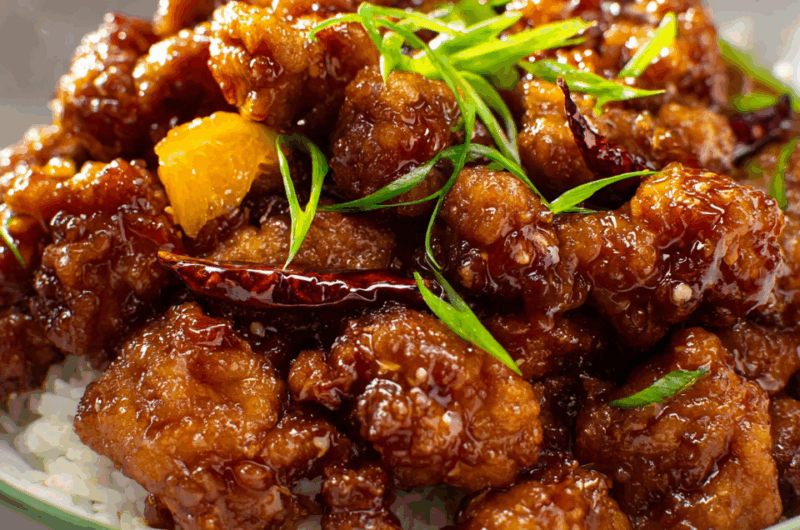The perfect mix of crispy, saucy, and spicy, General Tso’s Chicken is a restaurant classic you’ll love making at home. Deep-fried chicken thighs coated in a rich, garlicky glaze with the ideal balance of heat and sweetness—it’s easy to see why this is a crowd favorite.
Whether you’re craving bold Asian flavors or want to impress guests with a punchy homemade takeout meal, this recipe delivers. Serve it over fluffy rice or pair it with steamed veggies for a dish that’s as satisfying as it is flavorful. Once you try this homemade version, you might just retire your takeout menu.
Full Recipe:
For the Chicken:
-
1 lb boneless, skinless chicken thighs, cut into bite-sized pieces
-
1 egg
-
1 cup cornstarch
-
½ cup all-purpose flour
-
Oil for deep frying
For the Sauce:
-
3 tablespoons soy sauce
-
2 tablespoons rice vinegar
-
2 tablespoons hoisin sauce
-
3 tablespoons sugar
-
1 tablespoon cornstarch
-
1 cup water or chicken broth
-
2 teaspoons sesame oil
-
2 cloves garlic, minced
-
1 teaspoon grated fresh ginger
-
1 teaspoon crushed red pepper flakes (adjust to taste)
-
3-4 dried red chilies (optional, for extra heat)
-
2 green onions, sliced (for garnish)
Directions:
-
In a medium bowl, beat the egg. Add chicken pieces and coat well. In another bowl, combine cornstarch and flour. Dredge the egg-coated chicken in the flour mixture.
-
Heat oil in a deep fryer or large pot to 350°F (175°C). Fry chicken in batches until golden brown and crispy, about 3-4 minutes per batch. Drain on paper towels.
-
For the sauce, whisk soy sauce, rice vinegar, hoisin sauce, sugar, cornstarch, and broth together in a bowl. Set aside.
-
In a skillet or wok, heat sesame oil over medium heat. Add garlic, ginger, red pepper flakes, and dried chilies. Cook for 30 seconds until fragrant.
-
Stir in the sauce mixture. Bring to a boil, reduce to simmer, and cook until sauce thickens, about 2–3 minutes.
-
Add the fried chicken to the skillet and toss to coat thoroughly in the sauce.
-
Garnish with green onions and serve hot over rice or steamed broccoli.
Prep Time: 15 minutes | Cooking Time: 20 minutes | Total Time: 35 minutes
Kcal: 420 kcal | Servings: 4 servings
The Legacy of General Tso’s Chicken
General Tso’s Chicken, a dish beloved by takeout enthusiasts across North America, carries a history as rich and flavorful as its signature sauce. While many believe it to be a traditional Chinese delicacy, its origins actually stem from the Chinese-American culinary evolution. Named after General Tso Tsung-t’ang, a 19th-century military leader from the Hunan Province of China, the dish itself likely never crossed his lips. In fact, it wasn’t until the late 20th century that this sweet and spicy fried chicken became a staple of Westernized Chinese menus.
The creation of the modern General Tso’s Chicken is largely credited to chefs such as Peng Chang-kuei, who introduced a version of the dish to the U.S. in the 1970s. His original recipe leaned more on the spicy and savory spectrum and was less sweet than the versions widely consumed today. Over time, as the dish was adapted to suit American palates, it took on a more syrupy, thick sauce with less heat and more sugar—leading to the indulgent, glossy dish we now associate with Chinese takeout.
The Fusion of Flavor and Texture
What sets General Tso’s Chicken apart is its masterful combination of contrasting elements. Each bite delivers a powerful burst of texture and flavor: the crispy coating of deep-fried chicken juxtaposed with a silky sauce that clings to every morsel. The sauce balances sweet, salty, tangy, and spicy components, often combining soy sauce, hoisin, rice vinegar, sugar, ginger, and chili flakes. It is both complex and comforting.
The chicken is typically double-fried, which gives it a craggy, crunchy crust that resists becoming soggy when mixed with the sauce. This texture is crucial, allowing the sauce to enhance, not overwhelm, the chicken. The magic of the dish lies in that textural harmony—the caramelization of sugar in the sauce against the savory depth of the soy and garlic, finished with a gentle burn from the dried chilies.
A Takeout Favorite Turned Home-Cooked Star
For decades, General Tso’s Chicken has been the go-to choice for American diners looking to indulge in something bold and filling. It sits beside other favorites like orange chicken, beef and broccoli, and sweet and sour pork. But in recent years, the convenience and confidence provided by easy-to-follow recipes have empowered more home cooks to recreate this restaurant-style dish in their own kitchens.
The growing popularity of Asian-inspired cooking shows and social media reels has spotlighted the beauty of this dish’s preparation. The sizzling of the frying chicken, the thickening of the sauce in a wok, and the final garnishing with green onions all make for highly watchable, mouthwatering moments that captivate audiences. This has helped demystify what was once considered a “chef’s-only” dish and has made General Tso’s Chicken a recurring weeknight favorite.
Healthier Adaptations and Dietary Considerations
While General Tso’s Chicken is not traditionally considered a light meal—given its deep-fried component and sugary sauce—there are numerous ways to make it more health-conscious without sacrificing taste. Many home cooks now opt to air-fry or bake the chicken instead of deep frying. This significantly cuts down on the fat content while still maintaining a decent level of crispiness.
In addition, adjusting the sauce to reduce the sugar and sodium content is quite easy. Replacing regular soy sauce with a low-sodium version and reducing the sugar by half or substituting with honey or maple syrup can still yield a flavorful result. Some even bulk up the dish with vegetables like broccoli, bell peppers, or snap peas to balance out the richness and add fiber.
For those avoiding gluten, using tamari in place of soy sauce and cornstarch instead of wheat flour for breading makes the dish safe without altering its essential taste.
Pairings That Complement the Dish
Traditionally, General Tso’s Chicken is served over steamed white rice or jasmine rice to soak up the sauce. However, modern interpretations go beyond that. Brown rice, cauliflower rice, or even soba noodles make excellent alternatives. Stir-fried vegetables like baby bok choy, Chinese broccoli (gai lan), or garlic green beans offer freshness and crunch to cut through the dish’s richness.
Another fantastic side is a simple cucumber salad dressed in rice vinegar and sesame oil, which adds a refreshing contrast and palate cleanser. Some even enjoy serving General Tso’s Chicken with steamed bao buns or lettuce wraps for a more playful presentation.
Cultural Significance and Popularity
Though not traditionally Chinese, General Tso’s Chicken has become an integral part of Chinese-American cuisine. It exemplifies the adaptability of culinary traditions across cultures. Like spaghetti and meatballs in Italian-American cuisine, it exists in a category of food that evolved far from its supposed homeland, yet is deeply embedded in the cultural food identity of its new environment.
For Chinese-American communities, dishes like General Tso’s symbolize both opportunity and compromise—the chance to introduce elements of traditional Chinese cooking while adjusting to American tastes. For many Americans, it was their first introduction to Chinese flavors and textures, laying the groundwork for broader culinary exploration.
Its popularity has endured despite decades of food trend changes, a testament to how deeply it resonates with comfort, flavor, and nostalgia. General Tso’s Chicken is often considered “gateway Chinese food,” drawing people in with its bold taste and leading them to explore other authentic dishes.
Tips for Success When Making at Home
The key to a successful General Tso’s Chicken lies in preparation. Getting all your ingredients chopped, measured, and ready to go (a technique known as mise en place) ensures a smooth cooking experience. The frying process and sauce-making move quickly, so there’s little time to pause once things begin.
Double-frying the chicken is another essential tip. The first fry cooks the chicken through and sets the crust, while the second fry adds crispness and prevents sogginess. Also, make sure your oil is hot enough—ideally around 350°F (175°C)—to ensure a crispy coating without excessive oil absorption.
Finally, balance the sauce to your taste. Some prefer it sweeter, while others want more vinegar or chili heat. It’s highly customizable, so don’t hesitate to adjust ingredients until you find your perfect blend.
Conclusion: Why This Dish Endures
General Tso’s Chicken is more than just a menu option—it’s a story, a flavor journey, and a cultural icon. It represents the blending of heritage and innovation, tradition and adaptation. Whether ordered from a local takeout spot or prepared with care in a home kitchen, it consistently delivers satisfaction in every bite.
Its staying power comes from more than its taste—it offers familiarity, excitement, and the warm comfort of a dish that always hits the mark. With its crispy texture, glossy sauce, and aromatic heat, General Tso’s Chicken continues to win over food lovers generation after generation.








